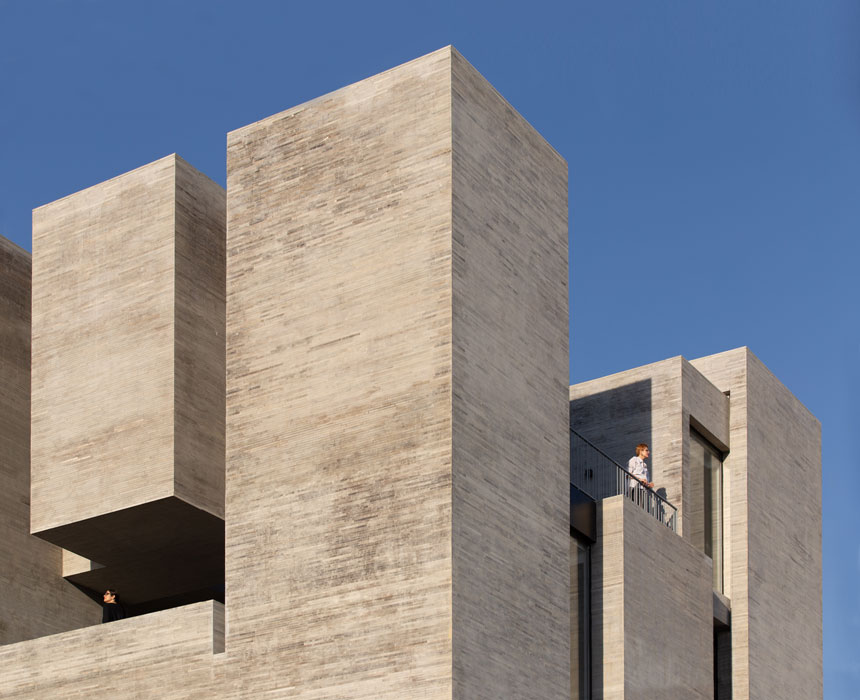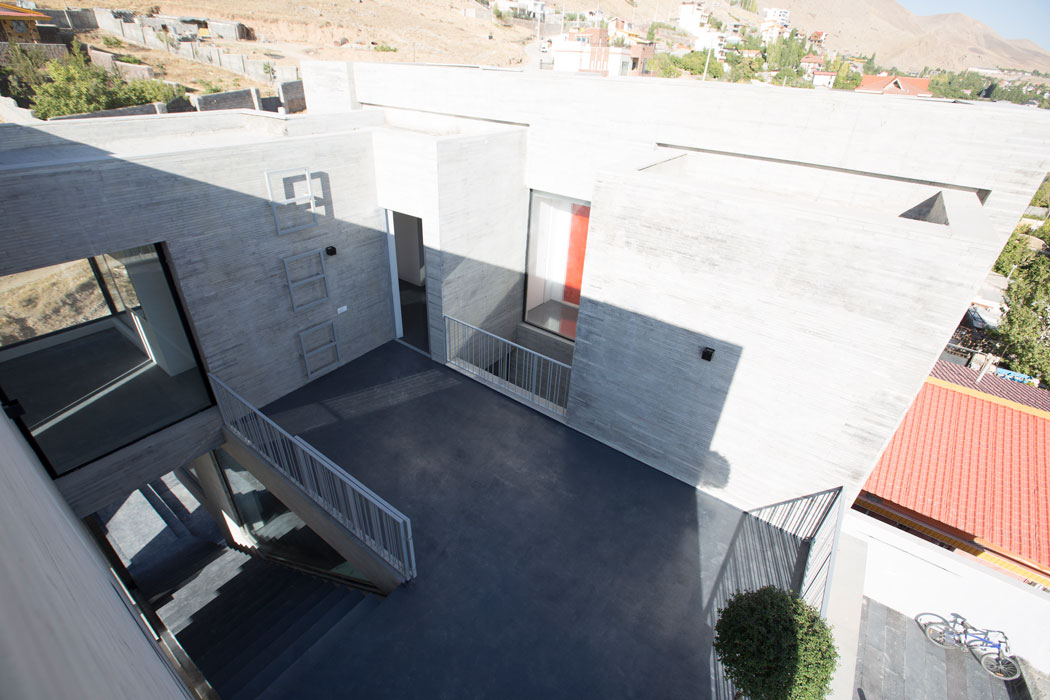- خانه
- معرفی پروژه
- طراحی معماری
- خانه آینه ورزان
منو
منو



























خانه آینه ورزان، خانه ای است نه تنها برای تعطیلات آخر هفته بلکه برای زندگی دائم زوج جوانی دارای بستری فرهنگی و اجتماعی متفاوت از بستر و بافت قرارگیری پروژه. در وهله نخست این تفاوت فرهنگی در بافت اجتماعی و کالبدی و خواست کارفرما رویکرد اولیه طراحی را به سوی طرحی درونگرا سوق داد؛ نقطه ای در تضاد با کارکرد بنا بصورت مجرد که بر مبنای استفاده از حداکثر نور، دید به پهنه سبز مشرف به ساختمان و کوه های البرز، گذر از خانه به حیاط و مابقی آنچه ما را امروزه از شهرهای بزرگ به روستاهای اطراف کشانده، قرار گرفته است.
ساحتی متفاوت، نیاز خانه ای را در آخرین و بیرونی ترین حلقه دارای مجوز ساخت روستا باید تامین میکرد، افزایش احساس امنیت و کنترل ساختمان برای ساکنین. با توجه به ابعاد زمین فضاهای داخلی در سه لایه متفاوت عملکردی تعریف شد. ۲ محور از هر سمت امکان عقب نشینی در لایه نورگیرها، پنجره ها و فضاهای ارتباطی را فراهم کرد تا پروژه بتواند همزمان کمترین امکان دیده شدن را از بیرون به درون و حداکثر امکان را برای دید، منظر و نور از درون به بیرون فراهم آورد.این دو محور نقشی ورای تامین نور و منظر ساختمان را برعهده دارند. شفافیت بین سه لایه در سطح افقی، کارکردی است که این دو محور در ترکیب با سه لایه عملکردی و خدماتی ایفا میکنند. این شفافیت ساختمان را در سطوح افقی قابل رصد وکنترل کرده است. علاوه بر این، این محورها در تداخل با فضاهای داخلی تولید ویدهایی میکنند که در نتیجه آن، کنترل و ارتباط بصری را در سطوح عمودی و بین طبقات در راستای رسیدن به بیشینه احساس کنترل ساختمان برای ساکنین از طبقه همکف به فضاهای طبقه آخر و بالعکس مقدور میسازد.
در تمامی طبقات علاوه بر ارتباط بصری چه به صورت افقی و چه به صورت عمودی، امکان عبور از این دو محور و گذر از لایه ای عملکردی به لایه دیگر نیز فراهم است. این امکان در طبقات و لایه های مختلف با ابزارهایی متفاوت عینی شده است:
– در طبقه همکف بازشوهای شیشه ای در جداره داخلی امکان گذر از لایه پذیرایی و ناهارخوری به آشپزخانه و بالعکس را فراهم کرده است.
– در طبقه اول این امکان با گذر از پل هایی از تراس به فضای کتابخانه و نشیمن و از نشیمن به اتاق خواب و پله ها فراهم میشود. این گذرها فضا هایی بینابینی هستند که در ارتباط با بیرون، در درون پروژه شکل گرفته اند و ارتباط بین فضاهای عملکردی داخل را ممکن می سازند.
– نفوذ و گذر در لایه های مختلف در سطح عمودی را پله ی موجود در محور اصلی ورودی ساختمان برعهده دارد. این پله امکان حرکت در لایه های عمودی فضاها را ایجاد میکند. همچنین با توجه به قرارگیری فضای کار در طبقه آخر، این پله ارتباط مهمانان کاری و مراجعین را بدون ورود به فضاهای خصوصی ساختمان فراهم میکند.
تراس ها با ۲ رویکرد و در ۲ طبقه در جبهه ای متفاوت نسبت به هم شکل گرفته اند. تراس طبقه آخر فضایی است محصوراز ۳ سمت با کمترین اشراف به همسایگی ها و بیشترین دید به دشت آبسرد؛ که در انتهای پله ورودی خانه ، فضایی برای دورهمی ها و مهمانی ها فراهم می کند. در مقابل تراس طبقه اول در انتهای گذر از نشیمن و کتابخانه قرارگرفته است؛ فضایی مسقف بوسیله کنسول غربی که در امتداد عملکرد کتابخانه و در ارتباط بصری با طبقات است. خانه آینه ورزان تجربه ای است برای ادراک فضاهای بیرونی در درون خانه، برای حداکثر دید و منظر در رویکردی درونگرا و پاسخی است به ارائه امکان کنترل پذیری ساختمان در مواجهه با لایه های مختلف، جهت نیل به افزایش احساس آرامش و امنیت در خانه.
Ayenevarzan House is the permanent residence of a young couple with a particular cultural and artistic background that differs from the social context of the neighborhood in which the project is located. Initially, this cultural difference and client’s desires and expectations propelled the project to an introverted design; a design that does not consider a building as a separate entity. The project revolves around taking maximum advantage of sunlight and scenic views of Alborz Mountains, as well as all other potentials that attract us from urban life to rural environments
The site is located at the periphery of the village, the furthest point that construction is allowed. This location required an approach that could create a sense of safety for the inhabitants. Based on the measurements of the site, we defined three functional layers for the interior spaces of the house. Two axes in either side of the building created a recessed layer that consists of windows, skylights, and corridors. This strategy minimized the visibility of the interior spaces from the outside and maximized the exposure to daylight and views to the surrounding landscape. The role of these two axes goes beyond providing daylight and view. Horizontally, two axes were defined between the three functional layers of the design. Transparency is the main feature of these axis which made the whole building observable and controllable.
Moreover, the intersection of these axes and interior spaces shaped vertical voids that connect various floors visually, and as a result, enhance the feeling of safety and control. Apart from this visual connection (both vertical and horizontal), the inhabitants can easily cross these axes and move between functional layers. Various elements make this possible in different floors and layers:
– The glass openings between the interior spaces in the ground floor allow access from dining area and reception room to kitchen and vice versa.
– In the first floor, the bridges that connect the balcony to the library and living room, as well as the living room to the bedroom and staircase play a similar role. Connecting inside with outside, these transitional spaces link different functions.
– The staircase located on the entrance axis allows movement between vertical layers. It also facilitates the access to the office on the upper floor without compromising the privacy of the inhabitants.
Two balconies, in two different floors and on two different façades, represent two approaches. The central staircase leads to a balcony on the top floor which is enclosed in three sides and has a spectacular view only to Absard fields, and not surrounding area. It is a gathering space for socializing and holding parties. On the other hand, the balcony on the first floor can be reached after passing the living room and the library. Providing visual connection to other floors, it is roofed with a cantilever in the western façade and is used as an extension to the library.
Ayenevarzan House aims at offering a new perception of the world outside from the interior space of the house. It enhances the visual connection to the surrounding area while adhering to an introverted approach in design. Augmenting the feeling of comfort and security, it offers a solution to the issue of control.
Opening the surface of the building and advancing towards the street while penetrating the interior using cantilevers and different layers, we created a transitional space; a space that could enhance natural lighting and provides spectacular views towards a variety of directions. On this layer, we moved different spaces forwards and backwards to create a semi-private zone for the inhabitants. This strategy set free an untapped potential: now the green sceneries on both sides of the site were as visible as the forest on the opposite side of the building. Extending outward from the façade, this layer is also utterly compelling from the point of view of the pedestrians.
As we enter the building, the immediate turn in the floor plan assures the separation between private and public spaces. Therefore, bedrooms have the least visual connection to other parts of home. Moreover, this turn allows sunlight and views to deeply penetrate the building. It also created a better composition of interwoven spaces centered around the kitchen, without blocking the views to the surrounding landscapes
” تمامی حقوق مادی و معنوی محتوا متعلق به پایگاه خبری جهان معماری می باشد “